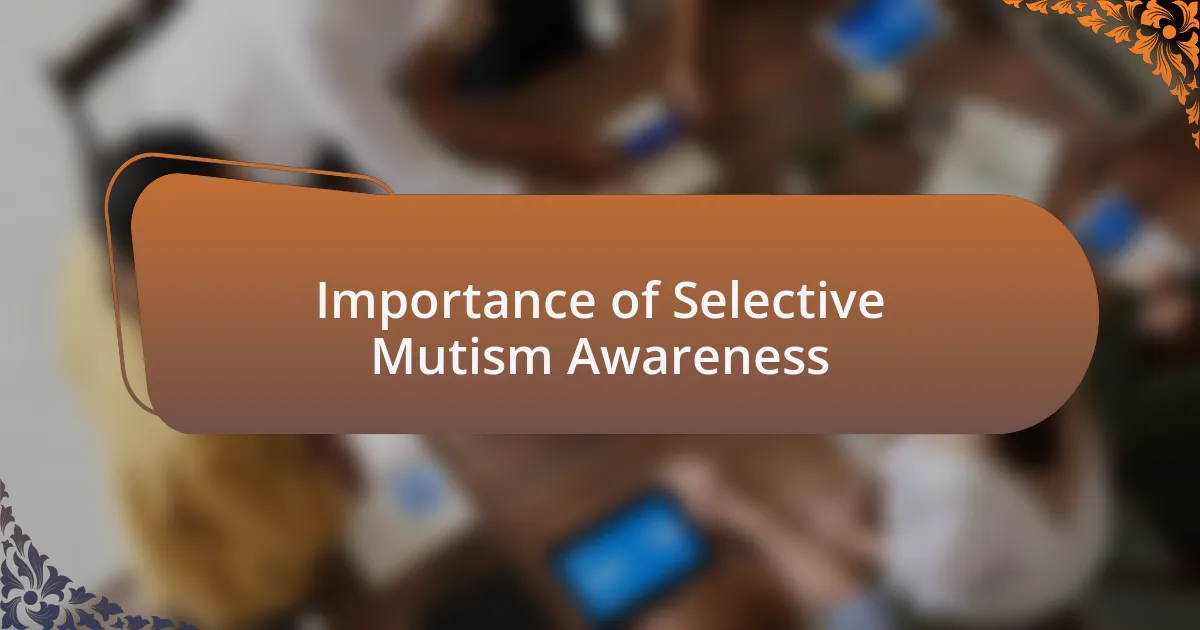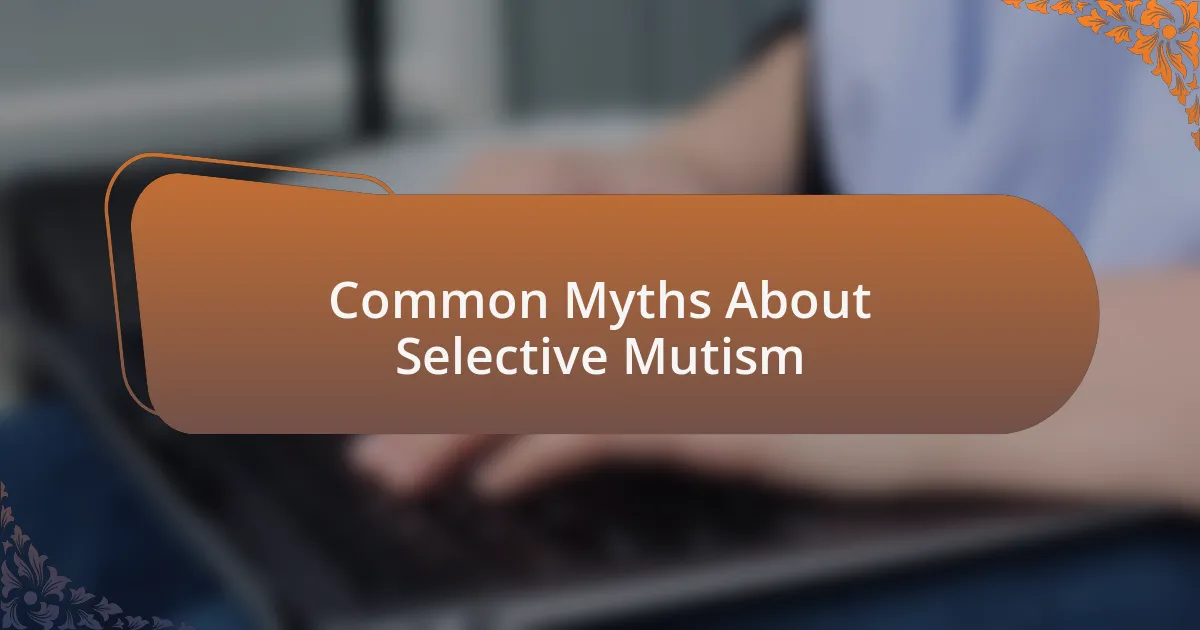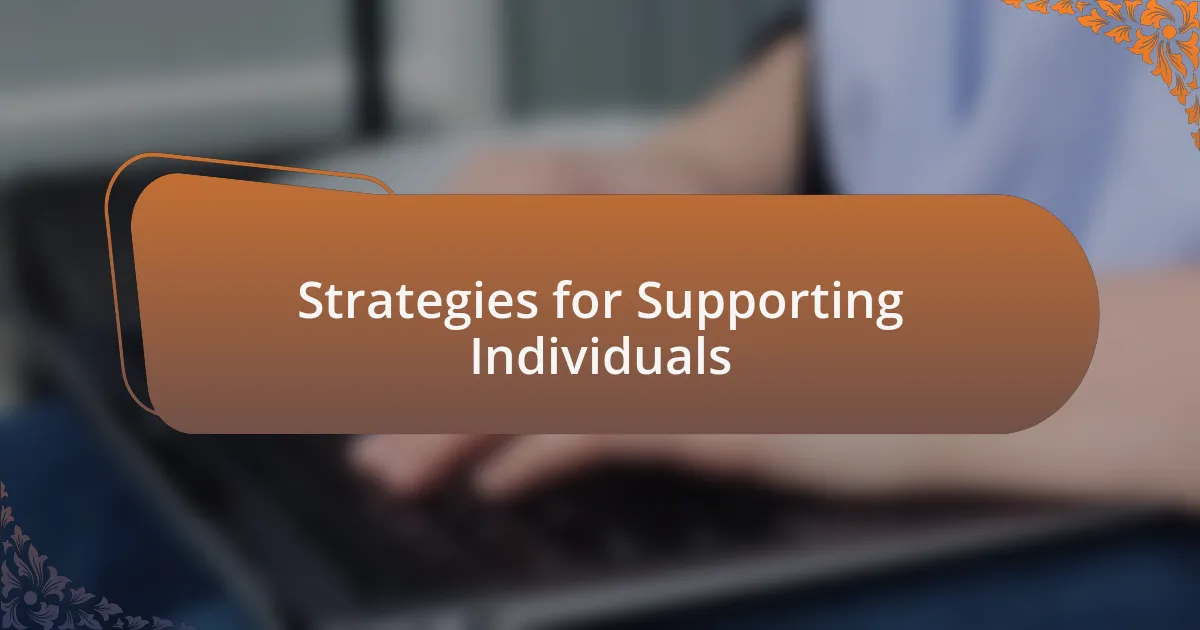Key takeaways:
- Selective Mutism is an anxiety disorder where children can speak comfortably at home but remain silent in social situations due to fear and anxiety.
- Raising awareness about selective mutism helps foster understanding and support, reducing stigma and promoting acceptance for affected individuals.
- Common myths include the misconception that selective mutism is a choice or a phase; intervention is crucial for long-term progress.
- Effective strategies for support include creating a safe environment, gradual exposure, and collaborating with professionals for tailored solutions.

Understanding Selective Mutism
Selective Mutism is a complex anxiety disorder primarily affecting children, characterized by an inability to speak in specific social situations, despite being capable of verbal communication in comfortable settings. I remember witnessing a close friend’s struggle with this condition. She was vibrant and talkative at home, yet completely silent during school presentations. How confusing must it have felt for her, trapped in a world where her voice seemed absent?
Understanding Selective Mutism goes beyond just recognizing silence. It involves realizing that the child’s refusal to speak is often rooted in deep-seated fear and anxiety, rather than a lack of desire to communicate. I often think about how bewildering it must be for parents who see their child thrive at home yet withdrawn in social settings. It’s a heartbreaking discrepancy that can leave families feeling helpless and unsure of how to provide support.
The journey toward understanding this disorder can be both enlightening and emotionally charged for all involved. I recall reading stories from parents who felt a mix of frustration and love, trying to navigate their child’s silence while encouraging steps toward communication. What makes a child feel safe enough to speak in one environment but not in another? Exploring these questions opens the door to empathy, reminding us that behind each silent moment lies a complex world of emotions and experiences waiting to be understood.

Importance of Selective Mutism Awareness
Heightened awareness of selective mutism is crucial for fostering a supportive environment for those affected. I remember attending a school meeting where teachers were introduced to this condition for the first time. Their initial misunderstanding shifted to genuine concern, illustrating how knowledge can transform reactions from frustration to compassion. Wouldn’t it be amazing if every educator could share that same commitment to understanding?
When we increase awareness, we create a ripple effect that can lead to better resources and strategies to help children find their voice. I’ve seen firsthand how support groups empower parents by sharing effective techniques that encourage communication. Imagine how comforting it must feel for a parent to hear that others are navigating similar challenges and finding success; it fosters a sense of community that breaks the isolation surrounding this disorder.
Ultimately, the importance of selective mutism awareness lies in its potential to lessen stigma and promote acceptance. I frequently think about how many children silently suffer because their struggles are misunderstood or ignored. Isn’t it vital for us to champion their voices, ensuring that every child has the chance to express themselves without fear?

Common Myths About Selective Mutism
One common myth about selective mutism is that children simply choose not to speak. Reflecting on my experiences, I’ve seen toddlers who were vibrant and chatty at home go completely silent in social settings. It’s crucial to recognize that this isn’t a choice but rather a response to anxiety and overwhelming social expectations. How can we help them unless we understand the underlying fears driving their silence?
Another misconception is that selective mutism is just a phase that children will outgrow without intervention. I recall speaking with a parent whose child had struggled for years, feeling helpless as they waited for their son to “snap out of it.” Unfortunately, ignoring the issue often leads to more profound challenges later on, reiterating why early support and understanding matter so much. Don’t you think we owe it to these kids to provide the resources they need to flourish?
Lastly, many believe that selective mutism only affects a child’s ability to speak in school environments. I’ve encountered families where the child’s silence extends deeply into all social interactions, even at home or with close relatives. This wide-ranging impact can lead to feelings of isolation for both the child and the family. Isn’t it essential for us to appreciate the broader implications of this condition so we can better support those navigating its complexities?

Strategies for Supporting Individuals
When supporting individuals with selective mutism, fostering a safe and comforting environment is vital. I remember a child who thrived when her classroom was arranged to resemble a cozy nook, complete with soft seating and calming colors. This simple change reduced her anxiety and encouraged her to engage at her own pace. Isn’t it fascinating how the right atmosphere can open doors to communication?
Incorporating gradual exposure strategies is another effective approach. I once guided a parent who implemented “practice” conversations at home, using role-playing to ease their child into speaking. This method built confidence through low-pressure scenarios, ultimately leading to more interactions with peers. Have you ever considered how small steps can lead to significant breakthroughs?
Lastly, collaborating with professionals, such as speech therapists or school counselors, can provide tailored strategies and support systems. I’ve seen how a well-rounded approach, involving educators and mental health experts, creates a united front that benefits the child. It’s essential to remember that no two journeys are the same; would you agree that personalized support can make a world of difference?

Personal Experiences with Selective Mutism
Experiencing selective mutism can often feel isolating, both for the affected individual and their families. I recall a candid moment with a young girl at a school event, where her silence spoke volumes. As she sat quietly in the corner, clutching her teddy bear, I could sense her eagerness to join the laughter around her. It made me wonder how many others might feel the same: unseen yet yearning for connection.
In my past interactions, I noticed that one-on-one relationships significantly aided in overcoming the hurdles posed by selective mutism. I once worked with a boy who was entirely non-verbal at school but came alive during our art sessions together. Through shared creativity, I witnessed him not only vocalizing his thoughts but also radiating joy. Hasn’t it often been said that shared experiences can bridge the widest gaps?
Reflecting on the role of patience in these journeys, I’ve learned that progress is often slow but immensely rewarding. There was a time when a child would whisper to me only after several weeks of building trust. When he finally spoke his first full sentence, it brought tears to my eyes. Isn’t it incredible how a single moment of courage can shine a light on a path that seemed so dark?

Lessons Learned from My Journey
Throughout my journey, I’ve learned the profound impact of listening. I remember a child who would often shift uncomfortably during our sessions, eyes downcast, while I rambled about what I thought would engage him. It wasn’t until I paused and truly listened to his silent cues that we found a rhythm. This taught me that sometimes the deepest connections form in the quietest moments. Who would have thought that silence could be so loud?
Furthermore, celebrating small victories has become a cornerstone of my approach. I vividly recall the day a non-verbal girl finally pointed to a picture of her favorite animal and smiled. That simple gesture transformed our sessions from daunting to delightful. Reflecting on it now, I realize that these tiny milestones are just as significant as monumental breakthroughs. How often do we overlook these little wins in our lives?
Lastly, embracing vulnerability has changed my perspective on growth profoundly. I remember sharing my own struggles with confidence during a group session, and seeing the relief wash over some faces. Their reactions reminded me that acknowledging our challenges can forge bonds and inspire courage in others. Isn’t it remarkable how vulnerability can pave the way for deeper connections and understanding?

Steps Toward Personal Growth
Taking tangible steps toward personal growth often begins with setting realistic goals. I once had a student who felt overwhelmed by the idea of speaking in front of others. Instead of asking her to deliver a full presentation, we broke it down into smaller tasks – like sharing a single word. Those tiny, manageable goals lit a spark for her. Have you ever noticed how starting small can create that empowering momentum?
Another key element is seeking feedback from trusted friends or mentors. I recall a time when I shared my thoughts on an approach I wanted to try, and a peer offered constructive criticism. At first, my instinct was to feel defensive, but then I realized how valuable that perspective was. Isn’t it fascinating how an outside viewpoint can reveal blind spots we didn’t even know were there?
Lastly, self-reflection plays a crucial role in this journey. I often take time to write in my journal about my experiences and emotions. There, I can unpack moments of doubt or joy without judgment. Through this practice, I gain clarity on my growth areas. How often do we take the time to check in with ourselves in our busy lives? Embracing this habit can be a game-changer, allowing us to understand our paths more deeply.